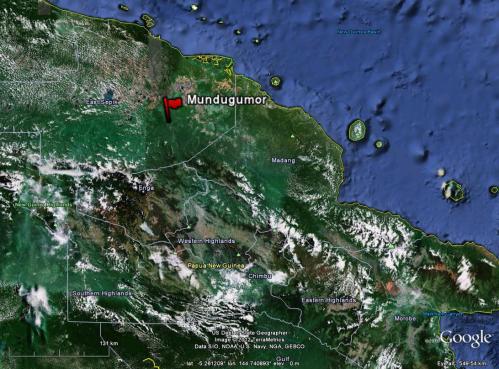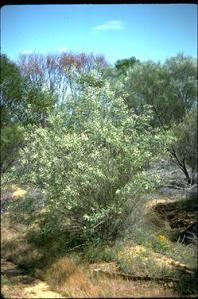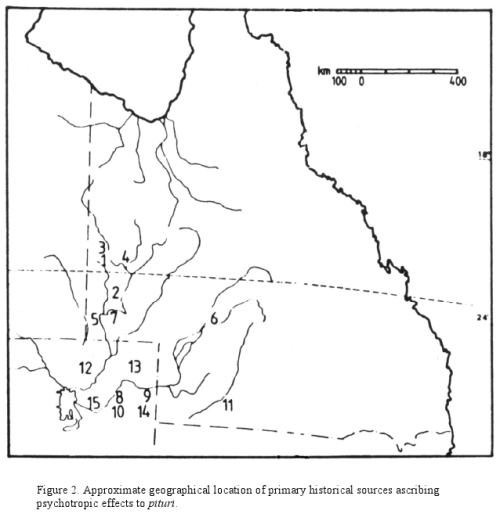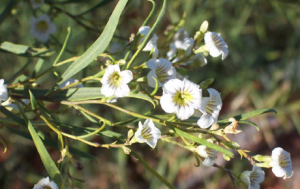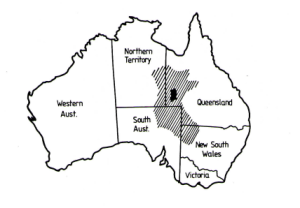But that raises yet another area of uncertainty. D. hopwoodii plants grew widely but sparsely on the tops of sandhills in the desert interior. It seems impossible that the plant’s natural pattern of growth could supply enough raw material to support the trade. Unless of course there existed some form of human intervention with the plant.
This is possible. While it is true that Aboriginal people were hunter/gatherers many of these groups, world-wide, could and occasionally did, manipulate certain favored plants to increase their presence in the group’s vicinity. In Australia, some Aboriginal groups ‘farmed with a fire-stick’, burning the landscape to encourage new growth which attracted grazing kangaroos. Alternatively Aboriginal people might manipulate root stock in some way; and very occasionally, a community sowed seeds. One report claims people burned the older branches of D. hopwoodii bushes. The observer interpreted this as increasing the yield of young green leaves and growing tips which contained the highest percentage of nicotine. But would this have been enough to supply raw material for the whole trade, or did the observer notice and record only part of a larger process? Certainly some plant manipulation must have happened to ensure the circulation of a such large amounts of pituri in the pituri trade.
Just as big a question, I think, is why Mulligan-Georgina pituri was so sought after in the first place. As I noted above, D. howoodii grew in many places in the desert. though ‘only sparsely’. Some communities recognized their local hopwoodii as the plant basis of pituri, and others such as the Arunta in central Australia produced a drug from their local plants. But by far the most valued, the most sought for, and possibly the mostly costly in terms of human effort, was the pituri made from D .hopwoodii plants growing in the Mulligan-Georgina region.
Why was this so? Spiritual values certainly played a significant part, perhaps an overwhelming one. Mulligan-Georgina. D. hopwoodii plants grew at a site along the path traveled led by one or more of the community’s totemic heroes during the Creation Period (the Dreamtime). So religion and ritual endorsed these plants rather than other plants. But then, why did this not this happen elsewhere where D. hopwoodii plants grew?
Here, I can offer only speculation. This particular tribal group may have produced a drug with a standardized level of toxicity. Considerable variation in the range of nicotine and nor-nicotine could be present within members of the same plant species. And there was variation too in the percentages of each alkaloid in relationship to the other in individual plants. Add to that the facts that nicotine is extremely toxic; that nicotine acts with the speed of cyanide; and that the gap between its maximum dose and its lethal dose is narrow. Clearly it was horrifyingly easy to miscalculate the correct quantity of pituri unless the drug was standardized. An amount of pituri sufficient to sustain a user on a long desert might, if improperly calculated, might render the user unconscious or dead. And given the small numbers of Aboriginal people that made up social groups, an occasional death could have larger social consequence for them in terms of food procurement, group viability and inter-tribal relationships, than the death by over-dose of one member might have for other members in a large industrialised society.
Standardizing a drug required two procedures, each necessary but insufficient without the other. The first is producing the drug from identical plants. The second necessary and essential procedure is identical curing methods. Different curing techniques, even when used on identical material, can produce drugs of different strengths. Web (1950) , a scientist with CSIRO states that curing alkaloid-containing plants must be a compromise‘where in shade or sun drying, artificial drying at high temperatures, or a protracted period at low temperatures … are all potent factors’ The problem lies with the plant enzymes. Even after harvesting, the enzymes continue metabolizing (breaking down) the alkaloids (in this case nicotine and nor-nicotine) in the leaves. Therefore the longer the drying time the weaker will be the drug, as the active ingredient continues to decompose until the material is thoroughly dry. Quicker drying with artificial heat would arrest enzyme action, but might also totally destroy the nicotine and nor-nicotine.
The solutions adopted by the pituri clans on the Mulligan-Georgina was the use of plants with already known alkaloid strengths, then careful drying by artificial heat . The last surviving member of the pituri clan of the Wongkongaru described the Mulligan-Georgina curing of pituri to George Aiston, the store-keeper in 1924. The informant was 80-90 years old at the time, and had been on expeditions the Wongongaru sent north to get pituri. His account of pituri processing techniques refers well back to a period before traditional practices fell into decline.
According to Aiston’s informant, the processing of pituri was accomplished by hereditary pituri clans in a ceremonial context. It was treated as a component of the secret knowledge monopolised by revered old men, and labour was compartmentalised by age and by space:
The secret of preparation was jealously guarded by the old men; the younger men were only allowed to accompany the party to the water nearest to the small clump of trees that were deemed to he the only true pituri. Here the younger men and the women stayed and prepared the bags to hold the prepared pituri and gathered food for the old men who did the harvesting. The old men went on to the trees, made a camp and built big fires. When these were burning down sufficiently they picked branch tips of the pituri bush, each about twelve inches at most in length. These were placed in a hole formed by taking out the fires down to the hot sand, were left to cook for at least two hours. When the steamed pituri was considered to be sufficiently cooked the sand was raked off and it was placed on a pirra to cool and dry. When thoroughly dry, it was beaten with the edge of a boomerang to break it up; all big twigs were picked out and the clean twigs bagged …
The great secret lay in the length of time that was needed for the steaming and this was not taught …(to)…the men until their beards were grey. When they were a ‘little bit Pinnaru’, that is, when the grey first showed in their hair and beard they might be allowed to accompany the old men to the picking ground, and would be allowed to fill the bags with the prepared pituri, but the actual cooking was done out of their sight. Sometimes, if the ground was hard, a hole was dug and the fire built in that, sometimes the fire was made close to a sand hill, and the sand was raked down from above. The method varied but the result was the same; too much steaming made the resulting ‘cook’ brittle and tasteless, too little made it musty (Aiston 1937:373 373).
From a technical point of view, there is no substitute for information that we might have gained by a chemical analysis of pituri immediately after processing. In lieu of this, the following comments are pertinent. According to Aisto n the plants were not picked until the fire was at a suitable level. This means that enzyme action probably ceased moments after picking, thus reducing nicotine loss to a minimum. The Aborigines believed, however, that the critical factor lay in the length of time allowed in the steaming process. This accords with western ideas on curing alkaloid-bearing plants. W. Griffin the expert on pharmacognosy I consulted previously, judged :
‘that what they have hit upon [that is the pituri clans in the Mulligan Georgina area] is a controlled drying process which from experience was sufficient to retard metabolism and yet insufficient to produce degradation or loss of active components (pers. comm.).
If this is so, pituri made by theMulligan- River- clans would be markedly more ‘user friendly’ in that its level of toxicity—whatever that may have been —would have been consistent. It is also possible that heat-drying broke down unwanted constituents in the leaves, changed odour, or flavours of components
How long have Aboriginal people used pituri? Perhaps as long as 5, 000 years, in the opinion of Professor Douglas Yen, a paleo-ethnobotanist and Professor of Prehistory at ANU (AustralianNationalUniversity) . In reviewing my material after its publication in 1983, Yen suggested that the development of pituri and its trade might slot into the period of social and economic changes in Aboriginal life which began about 5 000 years ago, perhaps coinciding with stability in sea levels. These changes included adoption of new stone technologies, the development of exchange (trade) networks along Dreaming Tracks, changes in the way people organized the land and related to other groups, and more intensified land use.
Inter-regional of pituri certainly belongs with these alterations in life style. But purely local use of pituri around the Mulligan /GeorginaRiversmay have been very much older than 5, 000 years. Indeed the availability of a highly valued and addictive drug plus alterations in methods of exchange recorded Sahlins may have been the causal factor for the economic and social changes Yen believes developed around this time.
***********
Complete Pituri Bibliography
Aiston, G. 1937 The Aboriginal narcotic pitcheri.Oceania7:372.
Bailey, F. 1883 A synopsis ofQueenslandflora.Brisbane: Government Printer.
Bancroft, J. 1872 The pituri poison. Paper read before the Queensland Philosophical Society.Brisbane: Government Printer.
1877Pituri. Paper read before the Queensland Philosophical Society.Brisbane: Government Printer.
1878 Further remarks on the pituri group of plants. Paper read before the Queensland Philosophical Society.Brisbane: Government Printer.
1879 Pituri and tobacco. Paper read before the Queensland Philosophical Society.Brisbane: Government Printer.
Barnard, C. 1952 The Duboisias ofAustralia. Economic Botany 6:3.
Basedow, H. 1925 The Australian Aboriginal.Adelaide: Preece.
Bedford, C.T. 1887 Reminiscences of a surveying trip from Boulia to the South Australian border. Proceedings of the Royal Geographical Society ofAustralia,QueenslandBranch 2:99.
Berndt, R.M. and C.H. 1977 The world of the first Australians.Sydney: Ure Smith.
Berndt, R.M. 1980Letter to P. Watson. June 1980.
Bottomley, W. & D.E. White 1951The Chemistry of Western Australian plants: Duboisia hopwoodii. Australian Journal of Scientific Research 4:107.
Buckland, A.W. 1879 Stimulants in use among savages. Journal of the Royal AnthropologicalInstituteofGreat BritainandIreland8:239.
Cleland, J.B. 1935 The native ofCentral Australiaand his surroundings. Proceedings of the Royal Geographical Society ofAustralasia, South Australian Branch 35:66.
1936 Ethno-botany in relation to the central Australian aboriginal. Mankind 2:6.
1940 The ecology of the Aboriginal inhabitants ofTasmaniaandSouth Australia. Australian Journal of Science 2:97.
Coghlon, N. 1980 Interview by P. Watson, May 20, 1980. Tape in possession of author.
Craig, B.F. 1970 North-west-centralQueensland, an annotated bibliography.Canberra: Australian Institute of Aboriginal Studies.
Curl, S.M. 1878 On pituri, a new vegetable produce that deserves further investigation. Proceedings of theNew ZealandInstitute 2:411.
Curr, E.M. 1886/7 The Australian race. 4 vols.Melbourne: Government Printer.
Duncan-Kemp, A.M. 1964 Where strange paths go down.Brisbane: W.R. Smith & Paterson.
1968 Where strange gods call.Brisbane: W.R. Smith & Paterson.
Durack, M. 1976 Kings in grass castles.Sydney: New Century Press.
Elkin, A.P. 1931 The social organization of South Australian tribes.Oceania2:44.
1934/35 Cult-totemism and mythology in northernSouth Australia.Oceania5:171.
El-Zughley 1970 Studies of the effect of reserpine therapy on the functional capacity of the tryptophanniacin pathway in smoker and non smokermales. Biochemical Pharmacology 19:1661.
Evans, R., K. Saunders, K. Cronin 1975 Exclusion, exploitation and extermination.Sydney:Australiaand New Zealand Book Company.
Everist, S.L. 1974 Poisonous plants ofAustralia.Sydney: Angus and Robertson.
Fagan, B.M. 1974 Men of the Earth.Boston: Little Brown & Co.
Farwell, G. 1975 Land of mirage.Adelaide: Rigby Limited.
Fraser, A. 1901 How the Aborigines about Kalliduararry make rain. Science of Man 3:116.
Friel, J. (ed.) 1974Dorland’s illustrated medical dictionary. Twenty-fifth edition.Philadelphia: W.B. Saunders.
Furst, P.T. (ed.) 1972 Flesh of the gods: the ritual use of hallucinogens.London: George Allen and Unwin Ltd.
1976 Hallucinogens and culture.San Francisco:Chandlerand Sharp.
Garber, S.T. 1942. Stedman’s Practical medical dictionary. Fifteenth edition. Baltimore: The William and Wilkins Company.
Gason, S. 1882 Letter to A.W. Howitt, Howitt Papers Box 1052/l(c) MS 9356. La Trobe Library, Melbourne.
Goodman, L.S. & A. Gilman (eds.) 1965 The pharmacological basis of therapeutics.New York: The MacMillan Company.
Greenway, J. 1963 Bibliographies of the Australian Aborigines and the native peoples ofTorres Straitto 1959.Sydney: Angus & Robertson.
Gregory, J.W. 1931 The story of the road.London: Alexander Maclehose and Co.
Hardesty, D.L. 1977 Ecological Anthropology.New York: John Wiley and Sons.
Harner, M.J. 1973 Hallucinogens and shamanism.New York:OxfordUniversityPress.
Harney, W.E. 1950 Roads and Trade. Walkabout 16:42.
Hicks, C.S. & H. Le Messurier 1935 Preliminary observations on the chemistry and pharmacology of the alkaloids of Duboisia hopwoodii. The Australian Journal of Experimental Biology and Medical Science 13:175.
Hicks, C.S. 1963 Climatic adaptation and drug habituation of the central Australian Aborigine. Perspectives in Biology and Medicine 7:39.
Higgin, J.A. 1903 An analysis of the ash of the Acacia salicina. Transactions of the Royal Society ofSouth Australia17:202.
Hodgkinson, W.O. 1877 North-west explorations. Parliamentary Paper.Brisbane.
Horne, G. & G. Aiston 1924 Savage life in centralAustralia.London: Macmillan.
Howitt, A.W. 1878 Notes on the Aborigines of Cooper’s Creek. In R.B. Smyth The Aborigines of Victoria App. D. Melbourne: Government Printer.
1904 The native tribes of south-eastAustralia.London: Macmillan and Co. Limited
Idriess,I.1941 The great boomerang.Sydney: Angus and Robertson.
Janiger, O. & M. Dobkin de Rios 1973 Suggestive hallucinogenic properties of tobacco. Medical Anthropology Newsletter 4:6.
Johnston, T.H. 1939 “Pituri”. Mankind 2:224.
Johnston, T.H. & J.B. Cleland 1933/4 The history of the Aboriginal narcotic, pituri.Oceania4:201.
Jones, R. 1969 Fire-stick farming. Australian Natural History. 16:224.
Kennedy, J.F., P.J. Skerman, F.W. Whitehouse, C. Ogilvie 1949
The Channel Country of south-westQueensland. Report to the Minister for Lands.Brisbane: Bureau of Investigation. Department of Public Lands. Government Printer.
La Barre, W. 1970 Old and new world narcotics: a statistical question and an ethnological reply. Economic Botany V24:368.
1972 Hallucinogens and the shamanic origins of religion. In P.T. Furst (ed.) Flesh of the gods: the ritual use of hallucinogens. 261. London: George Allen and Unwin.
Latz, P.K. and G.F. Griffin 1976 Changes in Aboriginal land management in relation to fire and to food plants in centralAustralia. In B.S. Hetzel and H.J.
Frith(eds.) The Nutrition of Aborigines in relation to the ecosystem of centralAustralia: 77Melbourne: CSIRO.
Lee, R. 1968 What hunters do for a living or, how to make out on scarce resources. In R. Lee and I. DeVore (eds.) Man the hunter.Chicago: Aldine.
Lewin, L. 1931 Phantastica, narcotic and stimulative drugs, their use and abuse.London: Kegan, Paul, Trench, Trubner.
Liversidge, A. 1880 The alkaloid from piturie. Proceedings of the Royal Society ofNew South Wales14:123.
MacGillvray, J. 1852 Narrative of the voyage of HMS Rattlesnake . . . during the years 1846-50.London: Boone.
Macknight, C. 1972 Macassans and Aborigines.Oceania42:283.
Madigan, C.T. 1938 The Simpson Desert and its borders. Proceedings of the 59 Royal Society ofNew South Wales71:503.
Maiden, J.H. 1893 The useful native plants ofAustralia.London: Trubner & Co.
Matthews, R.H. 1905Ethnological notes on the Aboriginal tribes ofQueensland.QueenslandGeographical Journal 20:51.
Mattingly, A.H. 1939Pitcheri. Wildlife 1:26.
McCarthy, F.D. 1939″Trade” in Aboriginal Australia and trade relationships withTorres Strait,New GuineaandMalaya.Oceania9:405, 10:80.
McCoy, A.W. 1980 Drug traffic: narcotics and organized crime inAustralia.Sydney: Harper and Row.
Micha, F.J. 1970 Trade and change in Australian Aboriginal cultures. In A.R. Pilling and R.A. Waterman (eds.) Diprotodon in DetribalizationEast Lansing:MichiganStateUniversityPress.
Moore, K.W. 1980 Letters to P. Watson. June 1980.
Moorehead, A. 1963Cooper’s Creek.New York: Harper and Row.
Morris, E.E. 1898 Austral English, a dictionary of Australian words, phrases and usages.London: Macmillan.
Mulvaney, D.J. 1975 The prehistory ofAustralia.Blackburn: The Dominion Press.
Peterson, N. 1979Aboriginal use of Australian Solanaceae. In J.G. Hawkes et al (eds.) The biology and taxonomy of the Solanaceae.London: Academic Press.
Rayment, T. 1946The valued pituri. Walkabout 13:42.
Revolutionary Health Committee ofHunanProvince1977
A barefoot doctor’s manual. Rev Edn Seattle: Cloudburst Press.
Robicsek, F. 1978 The smoking gods.Norman:UniversityofOklahomaPress.
Roth, W.E. 1897 Ethnological studies among the north-west-central Queensland Aborigines.Brisbane: Government Printer.
1901 Food: its search, capture and preparation.Brisbane:North QueenslandEthnography Bulletin 3.
Rowley, C.1978 The destruction of Aboriginal society. Harmondsworth: Penguin.
Sahlins, M. 1974 Stone Age Economics.London:Butlerand Tanner.
Schultes, R.E. 1940 Teonanacatl: narcotic mushrooms of the Aztecs. American Anthropologist V42:429.
1972 An overview of hallucinogens in the western hemisphere. In P.T. Furst (ed.) Flesh of the gods: the ritual use of hallucinogens.London: George Allen and Unwin.
1979 Solanaceous hallucinogens and their role in the development ofNew Worldcultures. In J.G. Hawkes et al (eds.) The biology and taxonomy of the Solanaceae.London: Academic Press.
Silvette, H., E.C. Hoff, P.S. Larson 1962 The actions of nicotine on central nervous system functions. Pharmacological Reviews 14:137.
Smyth, R.B. 1878 Aborigines ofVictoria. 2 vols.Melbourne: Government Printer.
Spencer, B. & F.J. Gillen 1927 The Arunta. A study of a stone age people. 2 vols.London: Macmillan.
Strehlow, T.G.H. 1965 Culture, social structure, and environment in Aboriginal centralAustralia. In P.M. Berndt and C.H. Bemdt (eds.) Aboriginal man inAustralia.Sydney: Angus and Robertson
1970 Geography and the totemic landscape in centralAustralia: a functional study. In R.M. Berndt (ed.) Australian Aboriginal Anthropology.
Taber, C.W. 1962 Taber’s cyclopedic medical dictionary.Oxford: Blackwell Scientific Publications.
Thomson, D. 1939 Notes on the smoking-pipes ofNorth Queenslandand the Northern Territory of Australia. Man 39:76.
Tindale, N.B. 1941 Survey of the half-caste problem inSouth Australia. Proceedings of the Royal Geographical Society ofAustralasia, South Australian Branch 42:66.
1974 Aboriginal tribes ofAustralia.Berkeley:UniversityofCaliforniaPress.
Vogan, A.J. 1890 The Black police. A story of modernAustralia.London: Hutchinson and Co.
Watson, P., O. Launratana and W.S. Griffiths. 1983. The Pharmacology of Pituri. Journal of Ethnopharmacology.
Watt, J.M. and M.G. Breyer-Brandwijk 1962 The medicinal and poisonous plants of southern and easternAfrica.Edinburgh: E. and S. Livingstone Ltd.
Webb, L.J. 1948 Guide to the medicinal and poisonous plants ofQueensland. CSIRO Bulletin 232.
1950 Alkaloids of Queensland flowering plants. Unpublished Ph.D. thesis,UniversityofQueensland.
Weiss, G. 1973 Shamanism and priesthood in the light of the Campa Ayahuasca ceremony. In M.J. Harner (ed.) Hallucinogens and shamanism.New York:OxfordUniversityPress.
Wells, F.H. 1893 The habits, customs and ceremonies of the Aboriginals of the Diamantina, Herbert and Eleanor Rivers, in east centralAustralia. Australian Association for the Advancement of Science 5:515.
Wilbert,J. 1972 Tobacco and shamanistic ecstasy among the Warao Indians of Venezuela. In P.T. Furst (ed.) Flesh of the gods: the ritual use of hallucinogens.London: George Allen and Unwin.
Wimberley, C.C. 1899 Letter to the Editor. Science of Man 2:69.
Wingate, P. 1978 The Penguin medical encyclopedia. Aylesbury: Hazell Watson and Viney Ltd.
Winnecke, C. 1886 Physical features ofCentral Australia. Proceedings of the Royal Geographical Society ofAustralasia,South Australia2:8.
Read Full Post »
